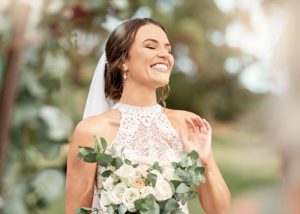Wedding photography, as the whole wedding business, is heavily affected by the ebb and movement of fashions. They change, they come, and they’re also constantly changing. When I jumped into the industry in the early part of 2012, I decided to study the industry to find out what’s working in the market, what’s a hit, and what is the most popular. I soon discovered that there’s a consistently reliable, predictable, and highly relied-on a collection of post-processing trends for wedding photography.
Below is a humorous overview of the trends. Although there are my personal opinions, I do believe that the majority of the ones below have valid points in their favor. Remember, this is all to have amusement!
The Au Naturale
In it is the most accurate rendition of the image. I liked my original edit due to its more consistent skin tones and darker greens that are slightly cooler (I used an altered VSCO preset). But I respect any photographer who opts for a natural rendering of the setting.
The Shoot & Burn
No photo is too clear or has overblown highlights. If your photographer is doing this, take a run, but do not walk. The images are being exported into MS Paint.
The VSCO
It’s because this filter is familiar: everyone uses it. The more robust your filter’s setting (more than ++’s) is, the better. Why would you need to exert more effort than just clicking a button?
The Tilt-Shift Surprise
Photoshop has made it simple to fix distracting details. If they’re creating a problem, include a field blur, and it won’t be a problem. Commonly, it is used for long shots that contain numerous details.
The Daguerreotype
The term “black and white” is a stretch grayer. It is used to hide the distracting details in medium- to close-up portraits and shots and conceal poor exposure.
The Dirty Polaroid
This “antique” is just coming out of the attic and has had the dust cleaned off. The good news is that this style is now a part of that of the Dodo bird. Fun alternatives: swap dust for water stains or patterns from your grandmother’s wallpaper.
The Moody Hipster
Do you think that sunny days are too average? Try this alternative to film simulation. For that rainforests-in-Oregon-on-a-cloudy-day feel, guaranteed. (Serious side note: I did not know that, despite the faded shadow effect being well-known, it is the effects of poor photography technique? In the past, the moment you sent an unexposed roll of film to a lab that was primarily for consumer use technician, they would manually push the prints and increase shadows, and then expose the grain of the film.[
The HDR
I look at this kind of look often, and I’m still trying to figure out the appeal of it. A photographer who is highly regarded in their field would make this type of flashy Technicolor beast. A majority of the techniques for post-processing in this list are employed to enhance an image, for example, by hiding a distraction or highlighting the strength. This approach brings out the worst in everything: The greens are toxic, the skin looks sunburnt, and it lacks all three-dimensionality. Do you have any theories on why certain photographers use this technique?
The Peaches & Cream
Pink, cream, or light yellow, choose your favorite. This trend is growing in popularity on various glamorous wedding-style blogs. What do you think about it? Tinting photos can dramatically enhance their appearance. It gives the image an overall color uniformity and blocks the unflattering and distracting colors. But, if you frame your pictures with care and a more precise rendition of the colors could provide the photos with more longevity. This is especially true if you realize that the fundamental importance of wedding photography can only be recognized in the future as past trends are simply another Buzzfeed article.
The Madame Tussauds Extravaganza
I often see this approach for the skin “enhancement” committed by photographers using a broad brush with a distinctly 1990s style. I wouldn’t say I like this method and it makes us appear like cherubs in Renaissance paintings. The results are not natural and waxy, which is why it’s called. Better results can be achieved using The Spot Healing Brush, a Wacom Tablet, and a lot of time.



